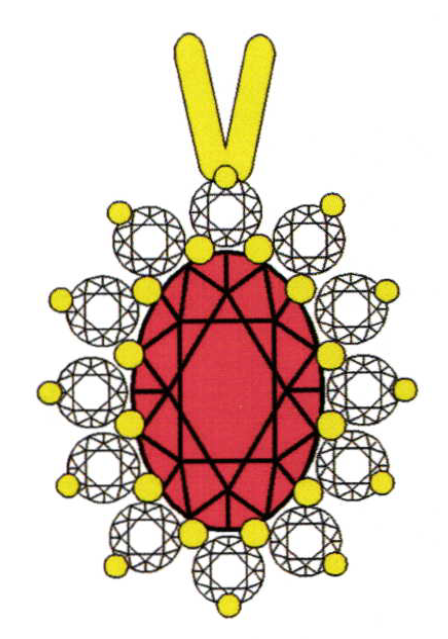Design Considerations for Pendants
2 Minute Read
When making a pendant the bail should be something that is incorporated into the design of the pendant if at all possible. Often jewelers will take something and stick a bail on top and call it a pendant, resulting in something that looks like something added onto it, rather than a complete design.
Rather than sticking a standard bail on top, why not incorporate the bail into the design of the pendant? In order to do this, it's important to know what type of chain and what size of chain the pendant is going to be worn on before you begin designing it.
In most cases pendants need to have a broad base and not be very tall. Most chains are flexible enough that the pendant can roll sideways. You don't want to taper the sides of a pendant as much as you would if you're creating a crown for a ring. The crown for a pendant needs to be less tapered, and more straight up-and-down. This will give you a broader base, and the pendant will lay flatter and not roll as easily.
In addition, if it is a tall pendant the center of gravity is high and the pendant will have a tendency to roll and turn over as the customer is wearing it. When you construct a pendant try to keep everything as low as possible. That will help to keep it from rolling or turning while the customer is wearing it.
When creating a pendant that has stones set in it, there is a design element that I like to include that isn't talked much about. If you look at stones, diamonds in particular, they are cut so that the light will reflect back out of the table of the stone. Looking at the stone straight down on the table will give you the most brilliance, the most sparkle from diamonds. Also well cut colored stones are cut to give the most color and the most life to the stone when viewed from the table.
If you set the stones into a pendant so they are straight (in other words the table is parallel with the back of the piece) all of the brilliance or all of the color will come straight out from the pendant. Because pendants are worn on a chain around the neck they are worn below the line of sight and so the most brilliance and color from the stones is going straight out from the pendant-not at the angle that people will view the pendant.
Because of this, when fabricating the crowns to set the stones, and when you set the stones, I believe they should be on a slight upward angle. In other words the table should be slightly lower at the top of the pendant than at the bottom of the pendant. This angle should be very slight, not so drastic of an angle that the stones look crooked, but just a couple of degrees. Then the stones are all angled toward the person's eyesight and when they view the pendant they will see the most brilliance and color from the stones. This is just a little thing, but often it's the little things that make the biggest difference.
For additional information see Layout Template on this article.
You assume all responsibility and risk for the use of the safety resources available on or through this web page. The International Gem Society LLC does not assume any liability for the materials, information and opinions provided on, or available through, this web page. No advice or information provided by this website shall create any warranty. Reliance on such advice, information or the content of this web page is solely at your own risk, including without limitation any safety guidelines, resources or precautions, or any other information related to safety that may be available on or through this web page. The International Gem Society LLC disclaims any liability for injury, death or damages resulting from the use thereof.
The All-In-One Jewelry Making Solution At Your Fingertips
When you join the Ganoksin community, you get the tools you need to take your work to the next level.
Trusted Jewelry Making Information & Techniques
Sign up to receive the latest articles, techniques, and inspirations with our free newsletter.



